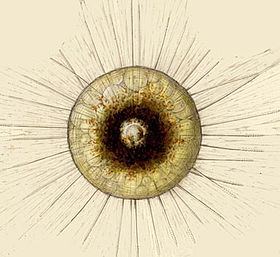Bikonta
(Redirecionado de Diphoda)
Um Bikonta é uma célula eucariota com dois flagelos. Outra característica partilhada pelos Bikonta é a fusão de dois genes: os genes para a timidilato sintase (TS) e dihidrofolato reductase (DHFR) codificam uma só proteína com duas funções (Cavalier-Smith, 2006). Estes genes são traduzidos em separado nos Unikonta.
| Bikonta | |||||
|---|---|---|---|---|---|
| Classificação científica | |||||
| |||||
| Supergrupos | |||||
| Cabozoa | |||||
| Sinónimos | |||||
Algumas investigações sugerem que um Unikonta (uma célula eucariota com um só flagelo) foi o antepassado dos Opisthokonta e Amoebozoa, enquanto que um Bikonta foi antepassado dos Archaeplastida, Excavata, Rhizaria e Chromalveolata (que inclui os Chromista e Alveolata).
A seguinte árvore filogenética mostra as relações entre os principais grupos de Eukaryota segundo as propostas mais recentes de Cavalier-Smith:[1][2][3][4][5][6]
| Eukaryota |
| ||||||||||||||||||||||||||||||||||||||||||||||||||||||||||||||||||||||||||||||||||||||||||||||||||||||||||||||||||||||||||||||
Ver também
editarReferências
- ↑ T. Cavalier-Smith, E. Chao & Rhodri Lewis 2019, Multigene phylogeny and cell evolution of chromist infrakingdom Rhizaria: contrasting cell organisation of sister phyla Cercozoa and Retaria. Volume 255, Issue 5, pp 1517–1574 https://doi.org/10.1007/s00709-018-1241-1
- ↑ Romain Derelle et al 2015, Bacterial proteins pinpoint a single eukaryotic root. Proceedings of the National Academy of Sciences 112(7) · January 2015 with 248 Reads DOI: 10.1073/pnas.1420657112
- ↑ Thomas Cavalier-Smith et al 2015, Multigene phylogeny resolves deep branching of Amoebozoa. Molecular Phylogenetics and Evolution Volume 83, February 2015, Pages 293–304
- ↑ Fabien Burki et al. 2015, Untangling the early diversification of eukaryotes: a phylogenomic study of the evolutionary origins of Centrohelida, Haptophyta and Cryptista. The Royal Society 2016 DOI: 10.1098/rspb.2015.2802
- ↑ Brown, M. W., Heiss, A. A., Kamikawa, R., Inagaki, Y., Yabuki, A., Tice, A. K., ... & Roger, A. J. (2018). Phylogenomics places orphan protistan lineages in a novel eukaryotic super-group. Genome biology and evolution, 10(2), 427-433.
- ↑ Lax, Gordon; Eglit, Yana; Eme, Laura; Bertrand, Erin M.; Roger, Andrew J.; Simpson, Alastair G. B. (2018-11-14). "Hemimastigophora is a novel supra-kingdom-level lineage of eukaryotes". Nature. 564 (7736): 410–414. Bibcode:2018Natur.564..410L. doi:10.1038/s41586-018-0708-8. ISSN 0028-0836. PMID 30429611
Referências gerais
editar- Thomas Cavalier-Smith (2006). «Protist phylogeny and the high-level classification of Protozoa». European Journal of Protistology. 39 (4): 338-348
- Alexandra Stechmann and Thomas Cavalier-Smith (2003). «The root of the eukaryote tree pinpointed». Current Biology. 13 (17)
